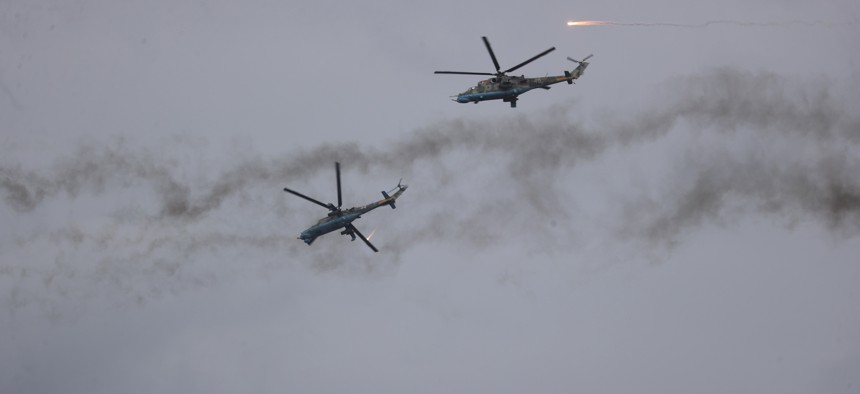
Russian and Belarusian armed forces take part in Allied Determination-2022 military drill in Gomel, Belarus on February 19, 2022. Stringer/Anadolu Agency via Getty Images
In an Information War, Be Careful What You Amplify
An announcement about an annual Russian reserve-forces exercise has some people speculating unhelpfully.
Staged car bombings. A mysterious Ukrainian operative making a televised confession. Announcements of Ukrainian attacks and resulting mass evacuations. A nuclear exercise. Russia is up to no good, and there’s every reason to fear what it might do next. Now a Feb. 18 Kremlin call-up order for a reservist exercise is causing even more panic—but wait! That exercise is, in fact, an annual occurrence.
Let’s certainly pay close attention to Russia’s plans, but let’s verify facts before adding to the panic.
Well-meaning Westerners seized on the reservist callup. “This is the order just signed by Putin ordering all army reserves to assemble. Ominous,” Bill Browder—the financier and Magnitsky-legislation activist—tweeted on Feb. 19. The order did indeed seem ominous, given that Russia has close to 200,000 troops lined up near its Ukrainian border and that the Kremlin and its proxies are carrying out almost daily provocations and false-flag operations intended to harm Ukraine. Lots of people retweeted concerned posts about the callup, by Browder and other popular Twitter accounts.
But the call-up was a far less dramatic event than the posters realized. “The Russian armed forces have conducted a reserve exercise every year since 2012,” Gudrun Persson, a Russia analyst at the Swedish Defense Research Agency and lead author of its much-used Russian Military Capability in a Ten-Year Perspective report, told me. “February has been the most common month for these exercises, followed by June, and all of the exercises have taken place in the first half of the year.”
Persson noted that these annual exercises usually involve some 5,000 to 6,000 troops, though the Kremlin wants to increase that number. Even if this exercise involves far more reservists than usual, the call-up is hardly a dramatic escalation. Indeed, like reservists in many other countries, those in Russia are hardly the tip of the spear.
“The Russian reserves are more competent than they were in 2012,” Persson said. “But the soldiers that are positioned around Ukraine are professional soldiers. When it comes to Russia, we should be concerned about a lot of things, but this call-up order is hardly one of them.”
In the frenzied atmosphere that Russia has created through its buildup at the Ukrainian border, it’s easily to believe it’s now calling up its reserves for an imminent invasion of Ukraine. And heck, why not share such a juicy announcement on social media? Verifying whether the exercise is simply this year’s edition of an annual event – most countries regularly exercise their reserves – can wait until later. Or maybe someone else can do it. In the event, a few Twitter accounts, including the Ukrainian news outlet Liveuamap, pointed out the less juicy reality of the exercise’s regular appearance, but predictably to far less effect than the dramatic social media posts.
What’s the harm in exaggerating the Russian threat? It’s harmful because the Russian threat is serious enough as it is. Around the same time as the Kremlin announced the reserve call-up, Russia conducted a nuclear exercise – certainly a serious signal. “And the nuclear exercise seems designed to provoke,” Persson noted. “It’s a regular exercise, but it normally takes place towards the end of the year. The fact that they decided to hold it now is a clear signal.”
Exaggerating the Russian threat is also harmful because it creates unnecessary panic in a situation that’s extraordinarily tense as it is. And it’s harmful because it, like all other forms of misinformation and disinformation, poisons our information environment.
Falsehoods are not just pieces of incorrect information shared by people who know the information is incorrect. Falsehoods are also incorrect information shared by people because they’re lazy or don’t know how to verify information. The former, disinformation, is a poison often spread by groups and countries that wish Western societies ill. The latter, though, is almost as poisonous, because it too disseminates falsehoods that distort people’s opinion-forming. It stands to reason that virtually nobody spreads alleged news of Russian provocations with ill intentions. But thanks to ill-considered social-media posting, this ordinarily boring event got enormous and panicked attention. What will happen next time Russia makes a mysterious move? What will happen when it does call up its entire reserves? Will anyone trust what they’re reading?
Verification is boring. Juicy news gets clicks. Perhaps there isn’t much harm in people thinking Russia has called up its reserves for an invasion of Ukraine. But the harm in people forming opinions based on incorrect information is incalculable. So is the harm of people deciding they can’t trust any information at all.





